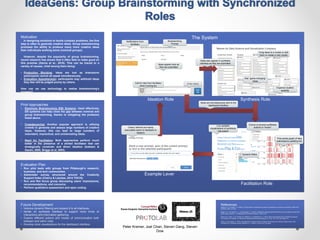
poster take 1
- 1. Peter Kremer, Joel Chan, Steven Dang, Steven Dow Motivation In designing solutions to tackle complex problems, the first step is often to generate creative ideas. Group brainstorming promises the ability to produce many more creative ideas than individuals working alone (nominal groups). However, despite the popularity of group brainstorming, recent research has shown that it often fails to make good on this promise (Zanna et al., 2010). This can be traced to a variety of causes, chief among them being: • Production Blocking: ideas are lost as brainstorm participants cannot all speak simultaneously. • Evaluation Apprehension: participants may withhold ideas they fear will be judged poorly by others. How can we use technology to realize brainstorming’s promise? Prior Approaches • Electronic Brainstorming (EB) Systems: Used effectively, EB systems can help close the gap between nominal and group brainstorming, thanks to mitigating the problems listed above. • Crowdsourcing: Another popular approach is utilizing crowds to generate and assess large numbers of creative ideas. However, this can lead to large numbers of redundant, impractical, and uninteresting ideas. • Need for Facilitation: Both approaches perform much better in the presence of a skilled facilitator that can strategically constrain and direct ideation (Isaksen & Gaulin, 2005, Briggs et al, 2003). Ideation Role Synthesis Role Facilitation Role Future Development • Improve dynamic filtering and expand it to all interfaces. • Iterate on synthesis interface to support more kinds of interactions and information gathering. • Explore different actions and modes of communication both between and within roles. • Develop more visualizations for the dashboard interface. References Isaksen, S. G., & Gaulin, J. P. (2005). A reexamination of brainstorming research: Implications for research and practice. Gifted Child Quarterly, 49(4), 315-329. Briggs, R. O., De Vreede, G. -J., & Nunamaker Jr, J. (2003). Collaboration engineering with thinklets to pursue sustained success with group support systems. J. Of Management Information Systems, 19(4), 31-64. Zanna, M. P., Olson, J. M., Stroebe, W., Nijstad, B. A., & Rietzschel, E. F. (2010). Beyond productivity loss in brainstorming groups: The evolution of a question. In Advances in experimental social psychology (Vol. 43, pp. 157- 203). San Diego, CA. Cherry, E. and Latulipe, C. (2014). Quantifying the Creativity Support of Digital Tools through the Creativity Support Index. ACM Transactions on Computer Human Interaction 21, 4, Article 21 (June 2014), 25 pages. Enter Ideas Notifications from facilitator Brainstorming Prompt Call for help from facilitator when running dry The System Organize clusters spatially Drag ideas to a cluster to add them or create a new cluster Ideas also appear in synthesis interface as they are submitted Star “game changing” ideas Ideas appear here as they are submitted Time series graph of idea submissions updating live Choice of several scaffolded actions or “levers” Live updated visualizations of synthesis role output Dynamic filters Example Lever Evaluation Plan • Run pilot tests with groups from Pittsburgh’s research, business, and tech communities. • Administer survey structured around the Creativity Support Index (Cherry & Latulipe, 2014 TOCHI) • Run and film focus group discussing users’ impressions, recommendations, and concerns. • Perform qualitative assessment and open coding Ideas are simultaneously sent to the dashboard interface Clearly defined and easily executable action to feedback to ideators